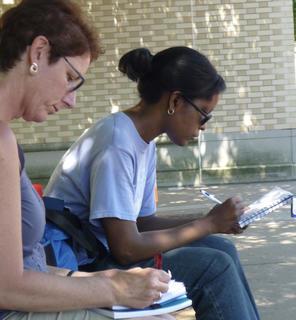
Me, Myself, and I: Inviting Students to Write to and for Themselves
We’ve completed the first week of classes, and campus is vibrant once more. Amidst the bustle of finding classrooms, following safe indoor practices, securing course materials, and navigating the various Canvas sites for their courses, students are apt to feel excited and nervous. Our efforts to prepare for the semester—by creating detailed and welcoming syllabi, crafting authentic and carefully sequenced assignments, and designing active learning activities that work well in various modes of instruction—will do much to establish an effective semester of learning. But, even with the careful planning, students will likely benefit from periodic opportunities to take stock of their personal and academic routines, and to adjust them, if needed, over the course of the semester. We can support our students in developing self-regulated learning habits by inviting them to engage in brief, self-focused and self-reflective writing activities—ones where the audience for the writing is the students themselves. Here are three suggestions for integrating self-focused writing—or writing for the self—into your courses.
Suggestion 1: Allot some time in class for personal writing activities at key moments throughout the semester.

Inviting students to write briefly about how they are thinking and feeling at the start of an assignment, in the midst of their learning, or just after they have completed work can support the development of self-regulated learning habits. Such activities often involve short, open-ended prompts that center on the student’s personal learning experience and needs. Student responses needn’t be collected or graded, though instructors can still signal their value by allocating time in class for their completion and by allowing students to share their responses voluntarily. Instructors can further reinforce the goal of writing for the self by encouraging students to communicate to themselves in the modes (text, drawings, emojis), dialects, and languages that are most resonant and effective for the student.
Here are some prompts that can be adapted to many different contexts of learning to support goal setting, strategizing, and student self-efficacy:
- What is one valuable or useful thing I have learned today?
- What is one unexpected or surprising idea I have heard in today’s class?
- Over the past week, what has helped my learning? What has hindered it?
- What ideas from the reading (or lecture or class discussion) do I think I can put into practice immediately?
- How do I feel about today’s reading/lecture/discussion?
- What goals do I have for this next assignment?
- What can I do to ensure I have the best opportunities to work effectively on this assignment?
Suggestion 2: Encourage students to use self-focused writing to prepare for conversations with you and others.
Talking about one’s writing can involve feelings of vulnerability and uncertainty. As Donald Murray (1979) has demonstrated, when students are given an opportunity to write to and for themselves in advance of a conference or a discussion, they are more apt to come prepared and willing to talk about their writing. Murray found great success in using these brief prompts to prepare students to talk about their writing:
- What have I learned from writing this piece?
- What do I intend to do in the next draft?
- What surprised me in the draft?
- Where is the piece of writing taking me?
- What do I like best in the piece of writing?
- How do I want others to support me with this writing?
Suggestion 3: Integrate self-reflective writing into longer assignment sequences.
Previous TWW posts (1, 2, 3) and our newly redesigned TWW Teaching Resources website offer suggestions and examples for how to integrate reflective writing and reflective memos into your courses. Often these self-reflective assignments—unlike the first two suggestions—are intended to be collected and read by the instructor as a way to guide students through the writing process. For such writing tasks, instructors should indicate that they will read, respond to, and possibly grade the students’ reflective writing. If instructors do intend to evaluate the student’s writing, they may want to avoid using criteria that emphasize the use of formal conventions and standards associated with other professional or academic genres and audiences.
We, Ourselves, and Us

One of the strongest ways we can model for our students the value of writing to and for themselves is to do it ourselves. If you assign a one-minute personal prompt in class, or you invite students to write for themselves as part of a contemplative practice, consider engaging in the activity yourself alongside your students. If you provide students with opportunities to journal about their personal learning, consider journaling as well. Have you had success with the use of self-focused writing activities? Are there prompts you’ve used that help students with developing self-regulated learning habits? Prompts you’ve used to support student self-efficacy? If so, please share them with others in the comments section below.
Further Support
Our newly redesigned Teaching with Writing Program webpage offers teaching resources to faculty members and instructors across the University of Minnesota system. We also host the popular Teaching with Writing event series each semester, offering workshops, panels, and discussions on writing-related topics. Visit the Writing Across the Curriculum Program and follow us on Twitter @UMNWriting. You can schedule a phone, email, in person or zoom teaching consultation through our online consultation form.
- Log in to post comments